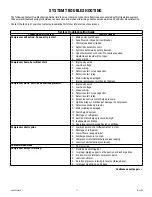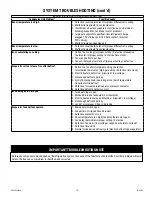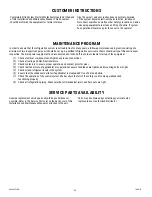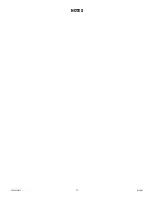
K90-KPCS-IM-2
18/04/22
- 6 -
Piping practice and line sizing charts as recommended by
A.S.H.R.A.E. or other reputable refrigeration standards must be
followed to ensure minimum pressure drop and correct oil return.
An inert gas such as dry nitrogen should be passed through the
piping during welding or brazing operations. This reduces or
eliminates oxidation of the copper and formation of scale inside
the piping. For specific piping requirements refer to your local
distributor or sales representative.
Correct line sizing is most critical because of the several factors
involved:
(a) Minimum pressure drop to ensure efficient
compressor performance.
(b) Sufficient gas velocity to maintain proper oil return
to the compressor under all load conditions.
(c) Elimination of conditions on multiple evaporators
whereby oil may log in an idle evaporator.
Suction Line:
Suction lines should be sized on the basis of a
maximum total pressure drop equivalent to a 2°F (
1.1°C
) change
in saturated temperature. At 40°F (
4.4°C
) suction temperature,
this is approximately 3 psig
(20.7 kPa)
for R-22. At -20°F
(-28.9°C)
suction temperature, this is approximately 1.3 psig
(9.0 kPa)
for
R-404A.
At the temperatures encountered in the condenser, receiver and
liquid line a certain amount of oil is always being circulated with
the refrigerant through the system by the compressor. However,
at the evaporator temperature, and with the refrigerant in a
vapor state, the oil and refrigerant separate. This oil can only be
returned to the compressor by gravity or by entrainment in the
suction gas. Roof installations leave no alternative but by entrain-
ment for oil return, so suction gas velocity and correct line sizing
to maintain this velocity are imperative. Care must be taken not to
oversize the suction line in the desire for maximum performance.
Gas velocity in vertical suction lines must not be less than 1,000
fpm
(5 m/s)
and preferably 1,250 to 1,500 fpm
(6 to 8 m/s).
Important:
A suction trap must be installed at the base of all
suction risers of four (4) feet or more in order to trap oil and allow
entrainment in the suction gas.
Appropriate line sizing practices must be used throughout the installation of the refrigeration system.
REFRIGERATION GRADE COPPER TUBING MUST BE USED FOR PIPING SYSTEMS.
IMPORTANT PIPING NOTE
All local codes must be observed in the installation of refrigerant piping.
WARNING
REFRIGERANT PIPING
TYPICAL SUCTION P-TRAP





















